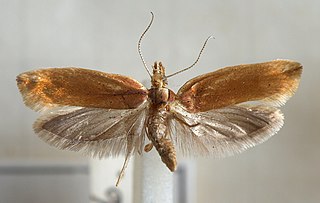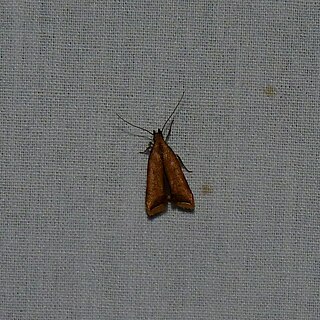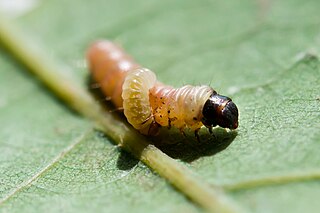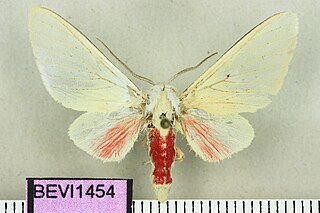
Ypsolopha ustella, the variable ypsolopha moth, is a moth of the family Ypsolophidae. It is found in most of Europe and is also present in North America.
Tortyra slossonia, the reflective tortyra moth, ficus budworm or Slosson's metalmark moth, is a moth of the family Choreutidae. It is known from Florida.

The many-spotted dichomeris moth is a moth of the family Gelechiidae. It is found in the United States, including Alabama, Maine, Maryland, Massachusetts, New Hampshire, Tennessee, Texas and Virginia.

The black-edged dichomeris or black-edged carbatina is a moth of the family Gelechiidae. It is found in the north-eastern United States, Korea, Japan, China, Taiwan and India. It has also been recorded in the Netherlands, where it is an exotic species.

Epipaschia superatalis, the dimorphic macalla moth, is a moth in the family Pyralidae. It is found in eastern North America.

Psilocorsis cryptolechiella is a moth of the family Depressariidae. It is found in the United States, including Alabama, Illinois, Massachusetts, Pennsylvania and South Carolina.
Evergestis rimosalis, the cross-striped cabbageworm, is a moth of the Crambidae family. It is found in most of the eastern United States.

Diaphania hyalinata, the melonworm moth, is a moth of the family Crambidae. It is found in eastern North America, south to Central and South America and the Caribbean.
Acallis gripalis is a species of snout moth in the genus Acallis. It was described by Hulst in 1886. It is found in North America, including Colorado, British Columbia, California and Arizona.

Acleris ferrugana is a species of moth of the family Tortricidae. It is found in China, most of Europe and has also been recorded from North America.

Psilocorsis quercicella is a species of moth of the family Depressariidae. It is found in the United States, including Florida, Maryland, Massachusetts and Oklahoma.

Epinotia trigonella, the birch epinotia moth, is a species of moth of the Tortricidae family. It is found in most of Europe, east to the eastern Palearctic ecozone. It is also found in North America.

Acrobasis caryae, the hickory shoot borer, is a species of snout moth in the genus Acrobasis. It was described by Augustus Radcliffe Grote in 1881, and is known from southeastern Ontario, Canada, and the eastern United States.

Acrobasis caliginella is a species of snout moth in the genus Acrobasis. It was described by George Duryea Hulst in 1878. It is found in the US states of California and Arizona.

Monopis weaverella is a species of moth in the family Tineidae. It is found in most of Europe and North America.

Ancylis geminana, the festooned roller, is a moth of the family Tortricidae. It was described by Edward Donovan in 1806. It is found in most of Europe and has also been recorded from North America. The habitat consists of fens, marshes and damp heathland.

Acleris schalleriana, the viburnum button or Schaller's acleris moth, is a moth of the family Tortricidae. It was described by Carl Linnaeus in 1761. It is found in most of Europe and is also found in North America.

Eupseudosoma involutum, the snowy eupseudosoma, is a moth of the family Erebidae. It is found from the southern United States (Florida) to Argentina, as well as on the Antilles.
Coleotechnites canusella, the banded jack-pine needleminer moth, is a moth of the family Gelechiidae. It is found in North America, where it has been recorded from British Columbia, Washington, Alabama, Arizona, Louisiana, New Mexico and South Carolina.
Anacampsis innocuella, the dark-headed aspen leafroller moth, is a moth of the Gelechiidae family. It was described by Zeller in 1873. It is found in North America, where it has been recorded from Alabama, British Columbia, Illinois, Indiana, Maine, Mississippi, New York, Nova Scotia, Ohio, Oklahoma, Ontario, Quebec and Vermont.

















